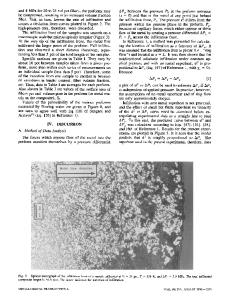Infiltration of fiber preforms by an
- PDF / 2,663,371 Bytes
- 9 Pages / 597 x 774 pts Page_size
- 77 Downloads / 337 Views
I.
INTRODUCTION
P R E S S U R E casting offers considerable potential for producing fiber-reinforced metals: adverse wetting is overcome and shrinkage pores are eliminated in a process that allows for high production rates. As in most casting operations, process parameters significantly influence the final macro- and microstructure of the resulting material in a way that must be understood before the process can be used in a reliable and optimized fashion. In two previous articles t~,21 (hereafter referred to as Part I and Part II, respectively), two of the present authors presented an analysis of the unidirectional infiltration of fiber preforms by a binary alloy. It was shown that when the initial fiber preform temperature is below the metal liquidus, solid metal forms in the composite during infiltration. This solidification phenomenon induces substantial macrosegregation and variations in grain size within the composite and strongly influences infiltration kinetics. The analysis was in good agreement with experimental data generated by infiltrating alumina fiber preforms with A1-4.5 wt pct Cu using an apparatus which allows infiltration under constant applied pressure with independent control of all process parameters. In this article, we present results from experiments on the pressure casting of aluminum-based alloys into chopped alumina fiber preforms in which the apparatus and procedures are less accurately controlled but replicate industrial processing conditions. We vary the initial fiber temperature T:, analyze microstructure and macrosegregation in the final composite, and investigate the applicability of theoretical analysis for the present casting conditions. P. JARRY, Research Engineer, A. DUBUS, Research Engineer, and R. TIRARD-COLLET, Technical Staff Member, are with the Centre de Recherches Pechiney, 38340 Voreppe, France. V.J MICHAUD, Postdoctoral Research Associate, and A. MORTENSEN, Associate Professor, are with the Department of Materials Science and Engineering, Massachusetts Institute of Technology, Cambridge, MA 02139. Manuscript submitted August 13, 1991. METALLURGICAL TRANSACTIONS A
II.
EXPERIMENTAL PROCEDURE
The fiber preforms were SAFFIL* 8-alumina pre*SAFFIL is a trademark of IC1 Americas, Inc., Wilmington, DE.
forms, 30 mm-thick and 120 mm in diameter, with an initial fiber volume fraction of 20 pct, essentially similar to those used and described in more detail in Part II. t21 Preform cohesion was ensured by the use of a few weight percent silica binder. The matrix was aluminum alloy AU5GT (4.4 wt pct Cu, 0.27 wt pct Mg, 0.18 wt pct Ti, 17 0 (different geometry)
Pet Preform Deformation 20 27 33
Data Loading...










